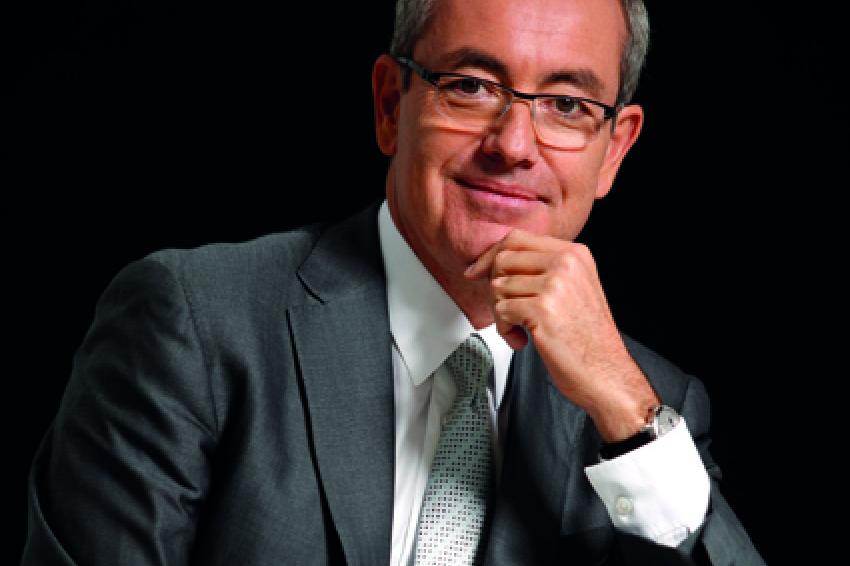A Catalyst for Change?
With the Integration of Rhodia, Solvay Strives to Become a Major Player in Chemistry
On May 11, 2012 Jean-Pierre Clamadieu succeeded Christian Jourquin as CEO of the Solvay group, since the consolidation of Rhodia in last year's third quarter one of Europe's leading chemical players. The former Rhodia CEO also took a seat on the Solvay board of directors. CHEManager Europe's Michael Reubold asked Clamadieu about shareholders' and management's vision for the newly merged Belgian-French group.
CHEManager Europe: Mr. Clamadieu, what is your vision for the new Solvay?
Jean-Pierre Clamadieu: Our vision as one of the world's top ten chemical companies is to be a strong leader in the reshaping of this industry. We also want to be a model of sustainable chemistry. It is our firm belief that chemistry has the ability to find solutions for some of the challenges that society faces. The Solvay family shareholders strongly support management on this. They clearly believe that the integration of Solvay and Rhodia should be a catalyst for change.
How solid a company is the new Solvay financially?
Jean-Pierre Clamadieu: In 2011, Solvay and Rhodia together generated pro forma sales of nearly €13 billion and EBITDA of over €2 billion. Implementation of our new strategy should put us in a position to increase EBITDA by 10 % year-on-year in average to €3 billion by 2016. This is challenging, but in our view achievable. Around €600 million of the improvement should come from organic growth. Here, innovation will play an important role, certainly helped by the fact that the merged companies have very significant R&D resources. The remaining €400 million should be achieved through operational excellence.
How will you achieve these targets, especially in view of the recessionary tendencies in parts of Europe and the slowdown expected in China?
Jean-Pierre Clamadieu: There will certainly be bumps in the road. But that's the name of the game. I don't expect the going to be easy but I also don't think we will have to wait until 2016 to start experiencing growth. If you look at our Q4 2011 results you will see that some businesses are faring very well, and in fact did not see a crisis.
While the targets are demanding they are by no means unachievable. After combining the two companies' assets we are already benefiting from purchasing synergies as well as cost efficiencies that will contribute to EBITDA over the next few years.
When the merger process is completed, what will the company's portfolio look like?
Jean-Pierre Clamadieu: I believe we already have quite a broad portfolio. A recently conducted analysis has enabled us to clearly assess the performance of each individual business and to identify growth engines. It shows that 90 % of our sales are transacted in markets where we are among the top three global players. Our three fastest-growing segments now account for about half of our overall trading activity.
The Specialty Polymers business supplies a range of applications from smartphone to medical equipment or oil and gas production. Rhodia's Consumer Chemical business, which manufactures shampoos and personal care products, is another growth pillar. In the third segment, Advanced Materials, which combines our rare earths and silicas, I think we are extremely well positioned. The recently agreed partnership of Rhodia and Germany's Tantalus Rare Earths to access rare earths in Madagascar is an example of our strategy to diversify resources.
Other of our other businesses, such as Acetow & Eco Services or Essential Chemicals, are essentially cash generators. We do not see huge growth opportunities, but we have a strong position. And then there are a couple of activities that are clearly cyclical, including vinyls and polyamide materials.
What place will cyclical businesses have in your portfolio? Is anything earmarked for divestment, perhaps vinyls? What does the future hold for polyamide?
Jean-Pierre Clamadieu: Although the new Solvay will not have a static portfolio, we feel under no pressure to do any streamlining short-term. In any case, before making divestment decisions, we have to be certain that we have the businesses in the right position. In PVC, we are clearly not there yet. Arkema's sale of its entire vinyls chain is not the type of deal we want to get into. To date, our polyamides business may not have returned the performance it should have, given our strong position. Improving our strategic position is certainly a goal here, too.
Will mergers and acquisitions play in shaping the new Solvay?
Jean-Pierre Clamadieu: We are looking at opportunities for bolt-on acquisitions here and there, and I think there are deals that can be done at any time. As regards more significant transformation, we are very busy integrating the two companies and we should first make sure everything is in place to deliver on our strategy. As soon as possible, however, we will be open to deals that might be bigger, more transformational, perhaps acquiring technology or specific access to some markets.
Is your new strategy focused on certain markets and regions? In which geographical areas do you see the most opportunities?
Jean-Pierre Clamadieu: Latin America - in particular Brazil - is very important. Both Solvay and Rhodia traditionally have strong positions there. Asia is well covered by both of the companies. China is obviously key because of the size of the market and the growth dynamic there. Korea and Thailand are also interesting. In India, we have a small position and are looking for opportunities to expand our presence. Russia, where Solvay has a €1 billion PVC project partnership with petrochemical giant Sibur, is also of considerable significance.
Considering the very different corporate cultures, what are the biggest challenges in integrating Solvay and Rhodia?
Jean-Pierre Clamadieu: It is true that the two companies developed differently in the recent past; however, looking at the overall picture I think our approach is in a lot of ways similar. We both have a strong industrial focus as well as a culture of responsibility and sustainability. Our integration teams have been working hard to understand any differences, but these are not as profound as some might imagine. Above all, we need to make sure that all of our 30,000 employees understand what the values of the new Solvay are and how they can contribute to our growth objectives.
How will the merger of activities affect the two workforces? Will there be any job losses?
Jean-Pierre Clamadieu: I have already said that there may be job reductions related to synergies. However, these will be limited and we expect to be able to offer a solution for a significant proportion of the affected employees to continue their career with us.
Earlier you mentioned the significant R&D resources of Solvay and Rhodia. Will any streamlining be done here?
Jean-Pierre Clamadieu: No, quite the contrary. We actually plan to spend more on R&D than the two legacy companies. In 2012 this should be about €240 million. Some 1,700 scientists work for us around the globe. We have a strong presence in Europe, with 40% of research concentrated in France because of the quality and the good conditions there.
The overriding objective is to improve our ability to innovate, with an eye toward increasing EBITDA. Rather than looking for cost-saving synergies, our R&D goal will be to allocate sufficient resources to projects where we think we can make a difference. Solvay already has a strong position in organic electronics, in OLED technologies, to mention one field. We are also devoting considerable effort to biosourcing of starting materials and we are working on a major project to increase the output of oil wells.
Kontakt
Rhodia Europe
110 Esplanade Charles de Gaulle
92931 Paris La Defense












